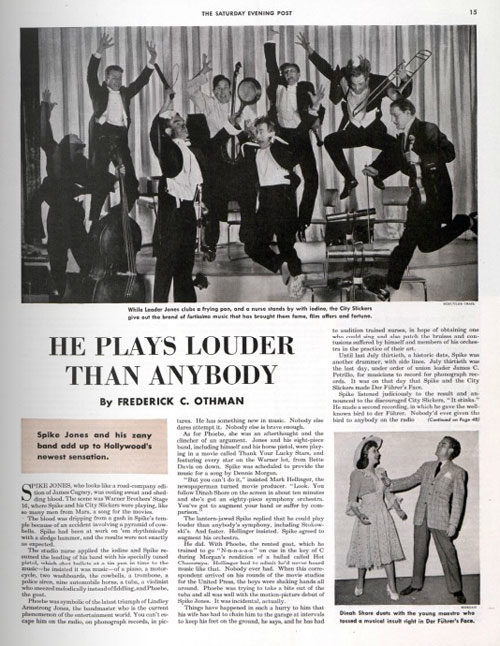Before “Weird Al” Yankovic, There Was Spike Jones
Every now and then, someone stumbles across one of Spike Jones’ recordings, and they’re amazed. Newcomers to the music of his City Slickers band find it manic, loud, imaginative, vulgar, and fascinatingly strange.
The first musician to build a serious legacy around novelty music, Lindley Armstrong “Spike” Jones started his career as a serious drummer. He even performed on Bing Crosby’s recording of “White Christmas.” But playing the same arrangements night after night bored him, so he found musicians who enjoyed playing satirical versions of popular songs. Spike Jones and His City Slickers began making recordings and, in 1942, had a big hit with “Der Fuhrer’s Face,” a sarcastic tribute to Hitler interspersed with flatulent notes.
The public loved it, especially when the song was incorporated into a wartime Disney cartoon starring Donald Duck.
The following year, the Post ran an article on Jones, “He Plays Louder Than Anybody,” which described his work at the frontiers of musical chaos. At the time, he was trying to find a goat that could bleat in the key of A, which would be a natural addition to his augmented collection of “instruments.” His percussion section already included brake drums, washboards, anvils, bird calls, foghorns, and set of cowbells that clanged across 10 different pitches.
Spike’s recordings are remarkable for the layers of sound effects — musicians hiccupping or gargling in time to the music, the maestro firing pistols to emphasize the beat — as well as the musical skill required to hold it all together. They’re even more remarkable when you realize they were all recorded live; recording tape and layering were years in the future.
Jones’ appeal was more than simply auditory. He delighted in satirizing the polished appearance of big-band leaders. At the time he was recording, band music was becoming smooth and mellow and was often performed by musicians in matching suits, with a sophisticated-looking bandleader dressed in an elegant tuxedo.
In contrast, Jones’ wardrobe clashed as much as his music. He wore thunderously loud suits in checks or garish stripes. Sometimes he’d slip into his leopard-skin morning coat.
By the early 1960s, though, music was changing. The big bands were losing popularity to rock ’n’ roll, which Jones didn’t know how to satirize. “My business is lousing up music. But how can you slaughter a tune that already is a mess?” he said.
Jones passed away in 1965, and the world of novelty songs has been more sedate ever since.

Featured image: Schuyler Crail, SEPS